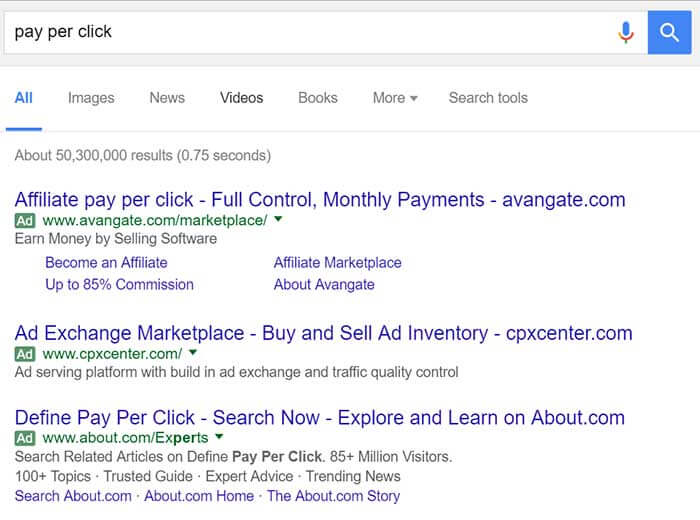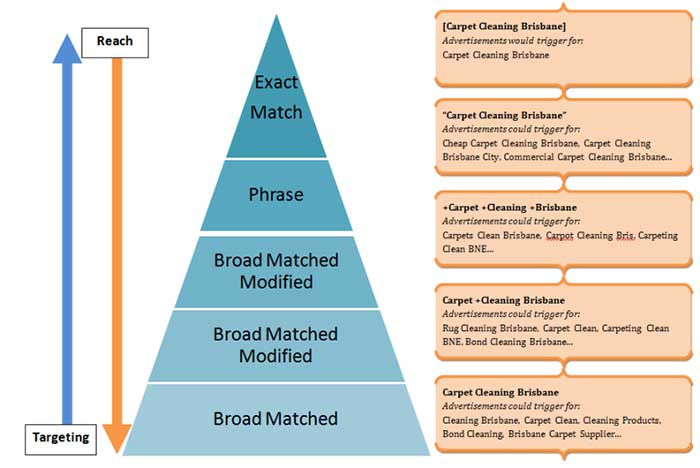Discover the meaning behind the three most popular letters in the Internet marketing and learn how to set up successful pay per click campaign for your business.
There’s no way you haven’t heard about Pay Per Click (PPC) advertising before. In the world, which revolves around moneymaking online, these three letters mean quite a lot, if not everything.
The following article is wholly dedicated to all things PPC and in just under 10 minutes you will learn:
- what PPC is
- how it differs from other types of advertising
- what the pros and cons of PPC are
- how to set up a successful PPC campaign
- how to calculate your results
So if you’re ready to get this PPC party started, let’s proceed to the definitions and establish the basis for further understanding of Pay Per Click advertising.
What Is PPC?
According to Wikipedia, PPC (pay per click), also known as cost per click (CPC), “is an Internet advertising model used to direct traffic to websites, in which an advertiser pays a publisher (typically a website owner or a network of websites) when the ad is clicked.”
In simpler words, major search engines like Google and Bing offer you a chance to drive some of their audience to your website via buying listings in their search results. Such listings are disguised as organic, non-paid search results (although they look slightly different). Every time a user clicks on this “sponsored” link, the search engine gets paid by the individual or organization that purchased this ad.
If you haven’t spent the past 20 or so years in complete isolation levitating in the middle of some cave, you have probably used Google, Bing, or Facebook a couple of times. Every time you did so, you may have noticed some strange links or banners which are different from the rest of the content. These are in fact PPC ads.

Whether or not you want to launch a successful pay per click campaign, it’s still important for you to know and understand, how modern Internet advertising works. Good marketers know that – you should too.
Here in this article we’ll concentrate mostly on how to set up PPC advertising campaign in Google, but it’s pretty much the same everywhere.
PPC as a Major Advertising Tool
Have you ever wondered how huge companies like Google or Facebook make money? They don’t produce anything. They don’t sell or resell you anything. They don’t get donations or stuff.
These companies make money off advertising. Yes, you got it right – advertising. The whole Google (or Facebook) pathos about changing the world to the better and serving people is nothing more than fancy words used to justify their existence. In fact, these companies are simply huge advertising agencies selling available ad spots to whoever wants to buy them.
How did they manage to become so successful? Well, in regular advertising you have to go out and search for your target audience. And even if you find it, you will have to struggle with people’s reluctance to being shoved something in their face.
In case of Google or Facebook, people come themselves, highly motivated and ready to act. Hey, you even have all their personal data, like age, gender, location, marital status, interests, and even behavior patterns.
In other words, these companies use large audiences they have built over time as potential customers for other people’s businesses. Whether it’s a good or bad thing, depends on your judgment. One thing we know for sure – this advertising model proved highly effective.
Pay Per Click vs. Cost Per Mille (CPM)
If you’re into Internet marketing, chances are that, along with the term “Pay per click,” you’ve also heard the term “CPM.” CPM stands for cost per mille, where “mille” is the Latin for “thousand.” Thousand advertising impressions that is (meaning how many times an ad was shown to the potential customer).
CPM is used in advertising business to estimate the overall cost of marketing campaigns. Its formula is as follows:

If you compare the two, you can clearly see that CPM-based advertising is much less targeted than PPC. It’s not necessarily worse or better – they just have their own purposes each.
From now on, we’ll be concentrating on PPC exclusively.
Types of PPC
Pay per click advertising on Google comes in two major forms – flat-rate PPC and bid-based PPC. Let’s see how they differ from each other.
Flat-rate PPC model is when you and advertiser agree on a fixed amount of money to be paid for every click. The rates can still vary depending on the search keyword or phrase in question, as such keywords as “loans,” “casino,” insurance,” or “mortgage” are obviously more valuable than “Chihuahua.”
Bid-based PPC model suggests that a client (publisher) only gets access to a private auction to bid for the highly prized keywords. The auction is hosted by the advertiser. The one, who offers the maximum amount of money, wins the auction and gets to run his/her ad first. These auctions are held automatically via specialized online tools.
Of course, bid-based model involves stronger competition and is designed to suck as much money as possible out of publishers.
Before we proceed to the detailed review of Google’s major PPC tool AdWords, let’s take a look at some of the pros and cons of pay per click advertising.
What’s Good About PPC
- It’s effective
The whole idea behind PPC suggests that you don’t spend unnecessary money. Your audience is out there. They’re waiting for you. All that you have to worry about is your message and your landing page, because that’s where you convert visitors into customers.
- It’s fast
It sure is. As soon as you opened an AdWords account and invested a couple of bucks, you can start generating some targeted traffic to wherever you want.
- It’s flexible
Pay as you go – you can spend as much or as little as you want. Try different keywords to see which works better. Choose between a phrase, broad keyword match, or exact match. You can even exclude the keywords you don’t want to be listed under – they are called negative keywords.
- It’s (relatively) cheap
Yes, some of the niche keywords or phrases are a true bargain – you can buy them for as low as $0.10. It doesn’t get any cheaper than that, does it?
What’s Not So Good About PPC

- it’s eating up your budget
It’s mainly true for bid-based PPC. A lot of people get caught in a bidding war for some precious keyword and may end up losing more money than earning. All the popular keywords have already been taken and you’ve got to deal with bid inflation every time you want to have one of these.
- it’s getting you junk traffic sometimes
When you don’t know how to set up a pay per click campaign yourself and order it through some advertising agency, not all of its PPC traffic comes straight from Google. These agencies don’t hesitate to use some of the darker and lesser-known corners of the Internet as well, but who cares? It’s all gonna look good in the global report.
- it doesn’t scale
This is the main problem of PPC so far. It’s not scalable. You can’t progress in the geometric rate. You can’t blow through the roof on PPC alone.
The more you earn, the more have to spend. Unlike some other types of user acquisition (like SEO), where you can invest time, money and effort once and then reap the rewards during a considerable amount of time, PPC requires constant investments.
To get some serious SEO tips and recommendations, be sure to check this “On-Page SEO Checklist: How to Build a Perfectly Optimized Website Page.”
How to Set Up a Successful Pay Per Click Campaign in Google AdWords

Step 1. Preparation
Say, you have created an AdWords account and threw in some money to form your budget. We will overlook such obvious self-explanatory settings as campaign language and schedule (see the complete list here), and move one to the ad groups.
Ad group is basically a number of ads targeted at a certain set of keywords. If your business is selling dog outfits, your ad group main contain such keywords as “dog outfits,” “buy dog clothes online,” “where to buy a nice coat for my Chihuahua” etc.
Now that we’re in the keyword department, it’s time to look at the different ways to customize your keywords as it’s crucial to your campaign success.
Step 2. Keyword Planning
AdWords allows you to choose the type of keyword match, based on the user query. These types are:
- broad match
It’s the default matching option, targeting your ads to any queries which Google algorithm deems relevant or synonymous.
While it may seem a good-to-go option at first because of the wider audience appeal, you may want to spend some time tweaking the keywords by using broad match modifiers.
So, in our example we can use such broad match as “+buy dog +clothes.” Why the “+” symbol? Because it indicates that variations are possible for the word, which it precedes, e.g. “get,” “purchase,” “order” in addition to “buy” and “outfits,” “coats,” “jackets,” “apparel” in addition to “clothes.” The keyword similarity and likeness are defined by Google algorithm and no one will ever tell you how it works. 😉
Your possible variations for this query can range from “buy dog clothes online” and “get cool pet outfit” to “why buying clothes for dogs is totally stupid.”
- phrase match
Phrase match is more precise – it will target ads only to queries that contain a certain phrase, or its close variation. It is more preferable for businesses because this way you can cut off unnecessary queries that may not be filtered by the broad match.
For example, when you set a “buy dog clothes” as a phrase match (to do so in AdWords you just need to put the phrase in quotation marks), you will definitely get shown for queries like “buy dog clothes online” and “get cool pet outfit,” but not for “why buying clothes for dogs is totally stupid.”
This narrows down your search to more or less real customers and leaves out BS queries you don’t want to have anything to do with.
- exact match
Exact match is, well, exact :). It only targets queries, which are identical match to the keyword, minus the spelling, and plural forms.
To make your keyword an exact match, just put it brackets like this: [buy dog clothes].
There’s also a special type of keywords that deserves mention – negative keywords. Although technically not a match type, they are still quite helpful in creating a successful pay per click campaign in Google AdWords.
Negative keywords are the keywords and phrases you don’t want to have your ad displayed under. They allow you to exclude some of the close or relevant searches, which are totally not your type.
For example, in our case it could be “-cat” because your business is only dog clothes. In this case, any cat-related queries will be ignored.
Keyword Summary
When it comes to down to the real campaign, it’s up to you to choose which type of keyword match to use as it all depends on your goals.
Generally, broader keywords indicate broader interest while exact keywords, especially containing product specifications, usually mean that a customer is more likely to purchase something.
Compare “buy dog clothes online” vs “buy Chihuahua coat online size eight.” Which of these two sounds more like a firm intent?
Another useful tool that might help is Google Keyword Planner. It helps you research and compare keywords before you choose the ones that are right for you. Do use it.
To wrap this up, here’s a nice little infographic for you illustrating the difference between keyword match types in Google AdWords.

source: sponsoredlinx.com.au
Step 3. Managing Your PPC Campaign
So you’ve got it all figured out and finally launched your pay per click campaign. What’s next?
You need to keep an eye on it, constantly monitoring and managing it to ensure the effectiveness.
Here’s a checklist for you:
- add more relevant keywords to your campaign to expand its reach
- split your ad groups to get a better targeting and improve your CTR
- revise your keyword list constantly to get rid of poor-performing and expensive keywords
- improve your landing page to match the keywords better and eventually increase conversion
Another important thing to consider is Ad Rank.
Ad Rank is another fancy algorithm created by Google to mess with determine the position of your ad on the page. Unfortunately, you won’t know how it works, because it just works the way it works.
Still, you need to know, what affects your ad rank. Here are the two major factors:
- your PPC bid
- the Quality Score of your keyword on a scale from 1 to 10
The higher your Quality Score is, the better. Ads that have high Quality Score:
- are exceptionally relevant to the search query
- usually have high CTR
- lead to a highly effective landing page, which shows an impressive conversion rate.
Just remember – user acquisition process is long and tedious. It doesn’t start and stop at a PPC ad. Whenever making a decision about your campaign, be sure to have all the steps of the process in mind.
How to Calculate Your Campaign and Manage Your Budget
This actually should have been the first point of our discussion, because it’s about the money and, in this case, your money. You don’t want to spend extra dollars on your PPC campaign, do you? If not, here’s an example of some basic calculations that everyone should do before going into full swing with your PPC campaign.
Calculation Example

Let’s say you have a few hundred dollars to spend on advertising. You also have a landing page that sells dog clothes online.
You’ve created a Google AdWords account, did some research and found the keywords you’re comfortable with. The PPC cost for them is $1.00 (just for this example). The overall funnel would look something like this:
PPC AD
↓
LANDING PAGE
↓
PAID ORDER
Each of these three steps has certain conversion, meaning that not all people who see the ad will click on it. Likewise, not all people who click on the ad and proceed to the next stage (landing page), will order something from you.
Let’s pay a little number game here and take a few guesses. For example, we want to see how much money we can generate if we invest $100.
$100 will generate us 100 clicks, therefore
- $1 per click * 100 clicks = $100
We know what the average conversion rate is for our landing page (e.g. 5%). So, these 100 clicks will give us
- 100 clicks * 5% conversion = 5 orders
And finally, we know that we get an average $25 profit from each order (minus taxes and all the costs). Therefore, our campaign will generate us
- 5 orders * $25 average profit per order = $125
Now, let’s compare the two sums – we invested $100 and earned $125. If you divide the return (net profit) by investment, you will get a ROI (return on investment) in percent.
- ROI = $25/$100 = 25%
Whether it’s a good thing or a bad thing, depends on your judgment. If your ROI is higher than 0%, you’re making money. If less, you’re not. It’s that simple.
Leveraging Your Results
Okay, you’re making money. But do you want to make more money? I bet you do. Sometimes it’s kinda hard to understand where to invest your newly earned money. Should you be spending more on advertising? Or should you be fighting to increase the conversion? Or is it something completely different? Let’s see.
Spending More on Ads
Let’s say, you decided to invest more money into advertising and buy more ads. For example, $500. How would that affect your ROI?
- $1 per click * 500 clicks = $500
- 500 clicks * 5% conversion = 25 orders
- 25 orders * $25 average profit per order = $625
- ROI = $625-$500/$500 = 25%
Guess what? Your ROI is the same. You’re making more money but only by spending more. Not a good business strategy.
Increasing Landing Page Conversion
What if you created a killer call-to-action (CTA) and increased your landing conversion from 5% to 10%.
Let’s see what happens then.
- $1 per click * 100 clicks = $100
- 100 clicks * 10% conversion = 10 orders
- 10 orders * $25 average profit per order = $250
- ROI = $250-$100/$100 = 150%
A six-fold increase in ROI! Now, that’s what I call leverage. See, a twofold increase in your conversion get you six-fold increase in ROI. Something to think about.
By the way, you can actually learn how to create killer CTAs by reading this article on “15 Tips How to Create a Call To Action That Will Double Your CTR”
Conclusion
You can add other variables as well, such as price, costs etc. and see how they affect each other. Sometimes when you change one variable, all other variables may also change. Just remember to do these calculations BEFORE you actually invest any money in PPC ads.
Good luck!
The right thing to do would be share this article with your friends on the social networks – just click on one of the icons of social media, it’s that easy.
If you have further questions on the subject, please write them in comments – I’ll be glad to answer.





Comments0